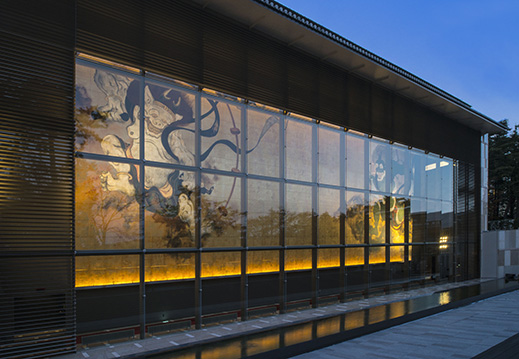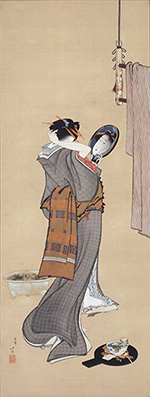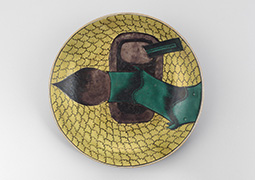 |
Focus features two in-depth reviews each month of fine art, architecture and design exhibitions and events at art museums, galleries and alternative spaces around Japan. The contributors are non-Japanese art critics living in Japan. |
|
|
 |
 |
 |
Exemplary Asian Art in Hakone: The Okada Museum of Art
Alice Gordenker |
 |
 |
|
The "face" of the Okada Museum of Art is this massive mural by Kotaro Fukui (b. 1969), viewed here at twilight from the outdoor terrace and footbath. |
Imagine it was your dream to build a museum devoted to Asian art, and you had the drive, means and resources to fill it with outstanding pieces over a wide range of genres. That, in a nutshell, is the story behind the Okada Museum of Art, the newest venue for traditional art in the culturally rich mountain resort of Hakone. The sprawling five-story structure, which opened in 2013, houses the personal collection of Kazuo Okada, an entrepreneur who made his fortune in gaming machines. According to Forbes Magazine, Okada is currently one of the 50 richest people in Japan.
What sets the museum apart from other private collections is that Okada bought systematically, with the clear intent of opening a museum. Right from the beginning he focused on outstanding works that could present key points in understanding Japanese art. As a result, it is possible to see -- in a short time -- works of the highest quality representing nearly every major period from ancient to contemporary. If you had time for only one cultural outing on a brief trip to Japan, a visit here would provide a reasonable overview of the country's artistic traditions.
Okada first love was painting, and it shows in the impressive exhibits of screens, sutras and hanging scrolls. In a foreword in the museum catalog, Okada recalls being "overcome by some indescribable power" when he first stood in front of a two-panel screen by Ogata Korin (1658-1716). That work, Ducks and Snow-Covered Pine Trees, was Okada's first major acquisition, and set him on a mission to preserve and share masterpieces of Asian art.
 |
|
Ogata Korin, Ducks and Snow-Covered Pine Trees (early 18th century), two-panel screen, color and gold on paper. |
|
 |
|
|
|
Katsushika Hokusai, A Summer Morning (ca. 1804-13), hanging scroll, color on silk. |
It's hard to single out works for special mention, but a highlight for me was the opportunity to see a number of paintings by Katsushika Hokusai (1760-1849) in one go. Hokusai is of course best known for woodblock prints, but he did make paintings and the Okada Museum owns ten, four of which are currently on view. Although most ukiyo-e prints and paintings in the bijin-ga (pictures of beautiful women) tradition depict courtesans or entertainers, the beauty in Hokusai's A Summer Morning is an ordinary woman at home. She has her back to the viewer, showing the designs of her kimono and obi, but her face is visible in the mirror she holds in hand. A man's kimono is hanging on a rack at the right, suggesting that the woman has risen early to tidy her appearance before her husband wakes.
Another work that has attracted considerable attention since the museum's opening is a massive hanging scroll by another famous ukiyo-e artist, Kitagawa Utamaro (?-1806). Titled Fukagawa in the Snow, it is part of a triptych commissioned by a wealthy merchant in the late 18th century. The three paintings were taken separately to Paris at the height of the Japonism boom in Europe. Two of its parts ended up in American museums; this section was presumed lost for over 60 years.
 |
|
Kitagawa Utamaro, Fukagawa in the Snow (ca. 1802-06), hanging scroll, color on paper. |
Other notable paintings in the collection include both color and ink works by Ito Jakuchu (1716-1800), an artist who is very much in vogue in Japan today. Modern masters of Nihonga (Japanese-style painting), too, are well represented, including Kaii Higashiyama (1908-99) and Matazo Kayama (1927-2004).
The second strength here is Asian ceramics, which make up about half of the museum's collection. The first-floor galleries are devoted to Chinese and Korean ceramics, and nearly every piece is a standout. I had intended to skip this floor entirely, since my main interest is Japanese art, but I ended up spending most of the morning there, admiring such treasures as brightly colored Jingdezhen ware from the Ming and Qing Dynasties and subtle celadons from 12th and 13th century Korea.
 |
|
Like stars in the night: the second floor spotlights two concurrent exhibitions of Edo-era Japanese porcelain. |
The entire second floor is currently given over to Japanese ceramics, including two special exhibitions that run through August 30: The Beauty of Traditional Japanese Porcelain and Elegant Edo Porcelain: The World of Ko-Imari. For anyone with even a passing interest in traditional ceramics, this is an excellent time to visit, as nearly 200 pieces of quality Japanese porcelain are on display. Many are being exhibited here for the first time.
One note for those with aging eyes: the exhibition rooms are darkened to the point that it is difficult to take notes. Fortunately, the works themselves are bathed in LED spotlights that bring out color and detail beautifully. I found this most helpful when viewing the ceramics, which can be particularly difficult to see when encased behind glass.
 |
|
 |
|
Left: large dish with design of calligraphy brush and ink stone. Right: square dish with angled corners and design of birds and flowers within hexagons. Both are Imari ware in the Ko-Kutani style, done in overglaze enamels. Edo period (mid-17th century). |
Located about 50 miles southwest of Tokyo, Hakone is a popular destination for Japanese and foreign tourists alike, and the museum is very welcoming to international visitors. Signage and captioning are provided not only in Japanese, but in English, Chinese, and Korean as well. In addition, about 50 touch panels distributed throughout the museum offer in-depth explanations of specific works, with the same choice of languages.
I'd recommend setting aside at least half a day for this museum, not only because there is so much to see and do, but also to get a good return on the relatively high admission. A ticket does get you free parking, a rarity in Japan, as well as a seat at the footbath, where you have the option to have a coffee or beer brought to you while your feet soak in Hakone's famous hot-spring waters. There is also a nice Japanese restaurant on the premises. You can break for a lunch with a view of the traditional garden, and then return to the museum for an afternoon of more exemplary Asian art.
All images courtesy of the Okada Museum of Art. |
 |
 |
Alice Gordenker
Alice Gordenker is a writer and translator based in Tokyo, where she has lived for more than 17 years. For over a decade, she penned the "So, What the Heck Is That?" column for The Japan Times, providing in-depth reports on everything from industrial safety to traditional talismans. She translates and consults for museums, and has a special interest in making Japanese museums more accessible for visitors from other countries. |
|
 |
|